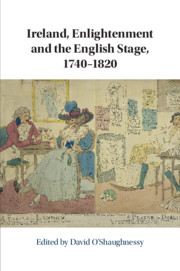Book contents
- Ireland, Enlightenment and the English Stage, 1740–1820
- Ireland, Enlightenment and the English Stage, 1740–1820
- Copyright page
- Contents
- Illustrations
- Tables
- Contributors
- Acknowledgements
- Introduction Staging an Irish Enlightenment
- Part I Representations and Resistance
- Part II Symbiotic Stages: Dublin and London
- Part III Enlightened Perspectives
- Select Bibliography
- Index
Part I - Representations and Resistance
Published online by Cambridge University Press: 22 July 2019
- Ireland, Enlightenment and the English Stage, 1740–1820
- Ireland, Enlightenment and the English Stage, 1740–1820
- Copyright page
- Contents
- Illustrations
- Tables
- Contributors
- Acknowledgements
- Introduction Staging an Irish Enlightenment
- Part I Representations and Resistance
- Part II Symbiotic Stages: Dublin and London
- Part III Enlightened Perspectives
- Select Bibliography
- Index
Summary
Actresses performing as Irish characters on the eighteenth-century London stage embodied the contradictions of national identity during the Irish Enlightenment. Playwright and actress Kitty Clive was the first to claim an ‘Irish-English’ identity and to turn topsy-turvy the notion of Irish inferiority. The chapter argues that more than their male counterparts, these actresses and the characters they played often served as intermediaries across gender, class, national and religious divides. The various parts for Irish women, largely comic, ranged from peasants and labourers to boisterous widows and would-be aristocrats. The most notable recurrent Irish characters are the cross-dressed and travestied women who perform roles that reveal fixed assumptions about gender and national identity and often expose English hypocrisy. Examples include Ann Barry in Garrick’s Irish Widow cross-dressed as her soldier brother; Margaret Doyle as Patrick in Holcroft’s Seduction; and Maria Macklin’s several roles playing a man or dressed as one, especially in her father Charles Macklin’s The School for Husbands. These women employed popular stereotypes but also attempted on occasion to empty them of their power. They are thus exemplary of the plight of immigrants who seek to assimilate while maintaining a distinct identity.
Keywords
- Type
- Chapter
- Information
- Ireland, Enlightenment and the English Stage, 1740-1820 , pp. 29 - 98Publisher: Cambridge University PressPrint publication year: 2019

